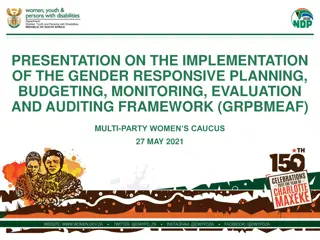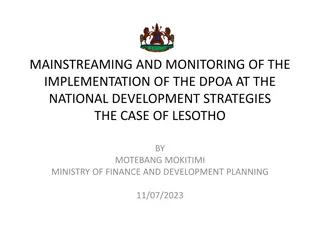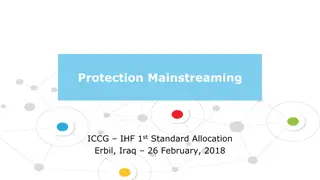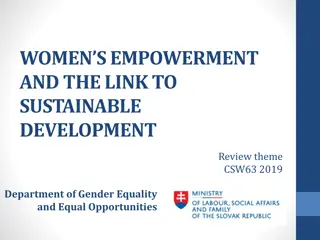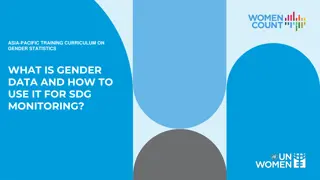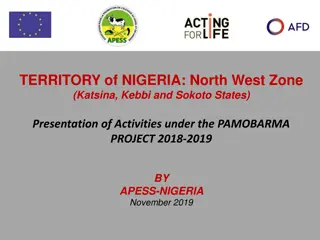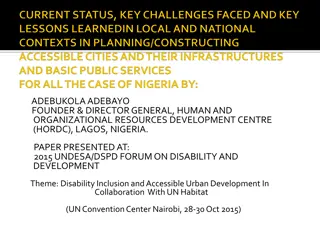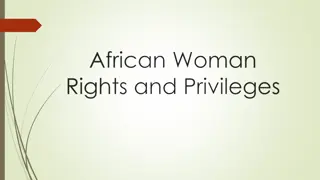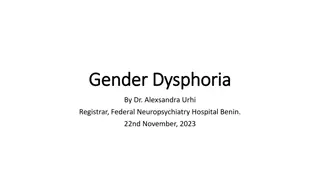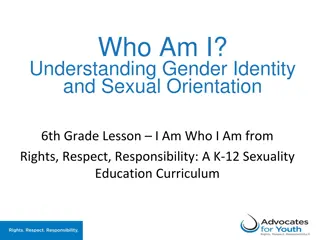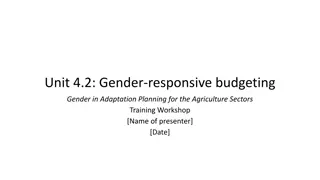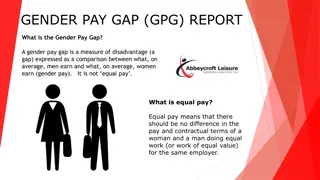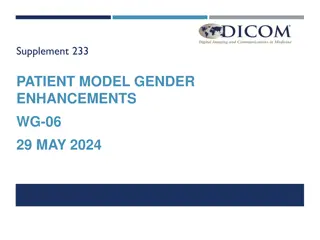Gender Mainstreaming in Nigeria: Cross-Cutting Issues
Nigeria has made progress in gender mainstreaming, with women's enrollment in education increasing and efforts to achieve gender equality in the workforce and political representation. Despite challenges like cultural prejudices, the National Gender Policy aims to empower women economically and socially for national development.
Download Presentation

Please find below an Image/Link to download the presentation.
The content on the website is provided AS IS for your information and personal use only. It may not be sold, licensed, or shared on other websites without obtaining consent from the author. Download presentation by click this link. If you encounter any issues during the download, it is possible that the publisher has removed the file from their server.
E N D
Presentation Transcript
GENDER MAINSTREAMING IN NIGERIA THE CROSS- CUTTING ISSUES PRESENTED By:- Mr. Isaiah Okoro Head, Gender Statistics Unit National Bureau of Statistics NATIONAL BUREAU OF STATISTICS
Nigeria at a Glance! Nigeria s population in 2014 is estimated at 179 million people Women constitute 49.5 percent of this Sex ratio now dropped from 103 men in 2006 to 102 per 100 women in 2014 Percentage of women enrolled in secondary schools increased from 45.3 percent in 2010 to more than 47 percent in 2014 NATIONAL BUREAU OF STATISTICS
Nigeria at a Glance! Females enrolled in primary school increased from 45.7 percent in 2010 to about 50 percent in 2014 Females enrolled in tertiary institutions increased from 44.9 percent in 2010 to 46.3 percent in 1013 MDG-3 calls for achieving gender parity in primary and secondary education, preferably by the year 2005, and at all level of education no later than 2015. NATIONAL BUREAU OF STATISTICS
Nigeria at a Glance! Labour force participation rate is 64.5 percent of the total women and 70.3 percent of total male HOUSE OF REPS 93.9% male and 6.1% female (2011) HOUSE OF REPS 96.3% male and 3.7% female (2015) SENATE 92.7% male and 7.3% female (2011) SENATE 94.5% male and 5.5% female (2015) NATIONAL BUREAU OF STATISTICS
Nigeria at a Glance! NATIONAL (HOUSE OF ASSEMBLY) 93.6% male and 6.3% female (2011) NATIONAL (HOUSE OF ASSEMBLY) 96.29% male and 3.7% female (2015) NATIONAL BUREAU OF STATISTICS
We all know that traditions, customs, sexual stereotyping of social roles and cultural prejudice continue to militate against enjoyment of rights and full participation of women on an equal basis with men in national development in Africa. And although there persists discrimination in Nigerian national and state statues, mainstreaming gender has been recognized as a cross-cutting issue in our national development agenda.
In this recognition, a national gender policy (NGP) has been developed in Nigeria to replace an erstwhile National Policy on women, to actually; Eliminate all such bearers Advance gender equality and reduce poverty levels Not only economically empowering women through income earnings, but also consciously empowering them to own production assets. NATIONAL BUREAU OF STATISTICS
For effective implementation of this policy, a national gender strategic framework (NGSF) was developed. The NGSF outlined explicit implementation, monitoring and evaluation guidelines for achieving measurable targets and enhancing accountability to gender equality and women empowerment. The objectives of the NGP are highlighted below as they constitute the driving force behind the strategic framework. Establish the framework for gender responsiveness in all public and private spheres. NATIONAL BUREAU OF STATISTICS
Develop and apply gender mainstreaming approaches, tools and instruments. Adopt gender mainstreaming as a core value and practice in social transformation, organizational cultures and in the general polity in Nigeria. Incorporate the principles of CEDAW and other global and regional frameworks that support gender equality and women empowerment in Nigeria s laws, legislative processes, and judicial and administrative system. Achieve minimum threshold of representation for women in order to promote equal opportunities in all areas of political, social and economic life. NATIONAL BUREAU OF STATISTICS
Undertake women and men specific projects as a means of developing their capabilities. Educate and sensitize all stakeholders on the centrality of gender equality and women s empowerment to the attainment of overall national development. NATIONAL BUREAU OF STATISTICS
As a nation, we are challenged by values, and we are using global standard instruments to formulate and assess our progress and achievements. These instruments are goals in themselves and tools for raising standards and informing the way policy and institutions work on the issues of gender equality and women s empowerment. Basically, Nigeria has made significant and satisfactory progress in the overall advancement and empowerment of women, particularly in the area of school attendance rates of girls, literacy rate of women and labour force participation rate of women. However, this is not the case in political participation. NATIONAL BUREAU OF STATISTICS
SUMMARY OF SEATS HELD IN NATIONAL ASSEMBLY BY TYPE, SEX AND YEAR SENATE YEARS PERCENTAGE CHART OF SEATS HELD IN NATIONAL ASSEMBLY (SENATE) BY SEX AND YEAR 2007 2011 2015 100% 90% Number Percent Number Percent Number Percent 80% 70% 60% Female 9 8.3 8 7.3 6 5.5 Male 50% Female 40% 30% Male 100 91.7 101 92.7 103 94.5 20% 10% Total 109 100.0 109 100.0 109 100.0 0% 2007 2011 2015 NATIONAL BUREAU OF STATISTICS
SUMMARY OF SEATS HELD IN NATIONAL ASSEMBLY BY TYPE, SEX AND YEAR HOUSE OF REPRESENTATIVE YEARS PERCENTAGE CHART OF SEATS HELD IN NATIONAL ASSEMBLY (HOUSE OF REPRESENTATIVE) BY SEX AND YEAR 2007 2011 2015 100 90 80 Number Percent Number Percent Number Percent 70 60 50 Female 26 7.2 22 6.1 14 3.9 Female Male 40 30 20 334 92.8 338 93.9 346 96.1 Male 10 0 2007 2011 Total 360 100.0 360 100.0 360 100.0 2015 NATIONAL BUREAU OF STATISTICS
SUMMARY OF SEATS HELD IN NATIONAL ASSEMBLY BY TYPE, SEX AND YEAR BOTH HOUSES YEARS PERCENTAGE CHART OF SEATS HELD IN NATIONAL ASSEMBLY (BOTH HOUSES) BY SEX AND YEAR Female Male 2007 2011 2015 Number Percent Number Percent Number Percent 92.5 Female 35 7.5 30 6.4 20 4.3 93.6 95.7 Male 434 92.5 439 93.6 449 95.7 7.5 6.4 4.3 2007 Total 469 100.0 469 100.0 469 100.0 2011 2015 NATIONAL BUREAU OF STATISTICS
SUMMARY OF SEATS HELD IN EXECUTIVE ARM BY TYPE, SEX AND YEAR EXECUTIVES YEARS 2007 2011 2015 Female Male %Female Female Male %Female Female Male %female President - 1 - 1 - 1 Vice - 1 - 1 - 1 President Governors - 36 - 36 - 36 Dep. 5 31 4 32 Governors NATIONAL BUREAU OF STATISTICS
These tables provide an assessment of the current and recent past situations and trends in the participation of women and men on positions of power and decision making across the Nigerian nation. Nigerian public governance is the most critical arena where inequality between men and women is highly visible. Limited female participation, as seen in the tables, in structures of governance where key policy decisions are made and resource allocation decided often has negative impact on women s political, economic and social opportunities. NATIONAL BUREAU OF STATISTICS
Although women make up about half of the electorate in Nigeria, and have attained the right to vote and hold public office in all the states of Nigerian federation, they continue to be under represented as members of National parliament. The importance of women s political empowerment has been recognized within the frame work of MDGs, with one of the indicators for monitoring goal 3 (promote gender equality and empower women) being the proportion of seats held by women in lower and upper houses of the National assembly. Here is a clear indication that the trend of our women political participation has been that of deterioration. NATIONAL BUREAU OF STATISTICS
Thanks for your attention NATIONAL BUREAU OF STATISTICS








